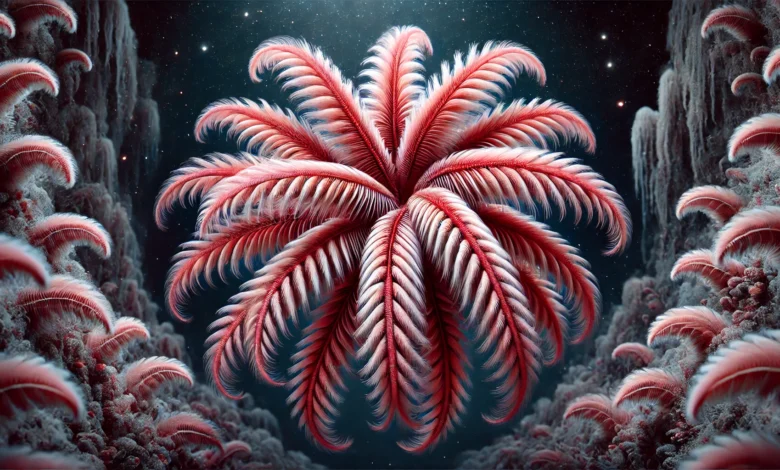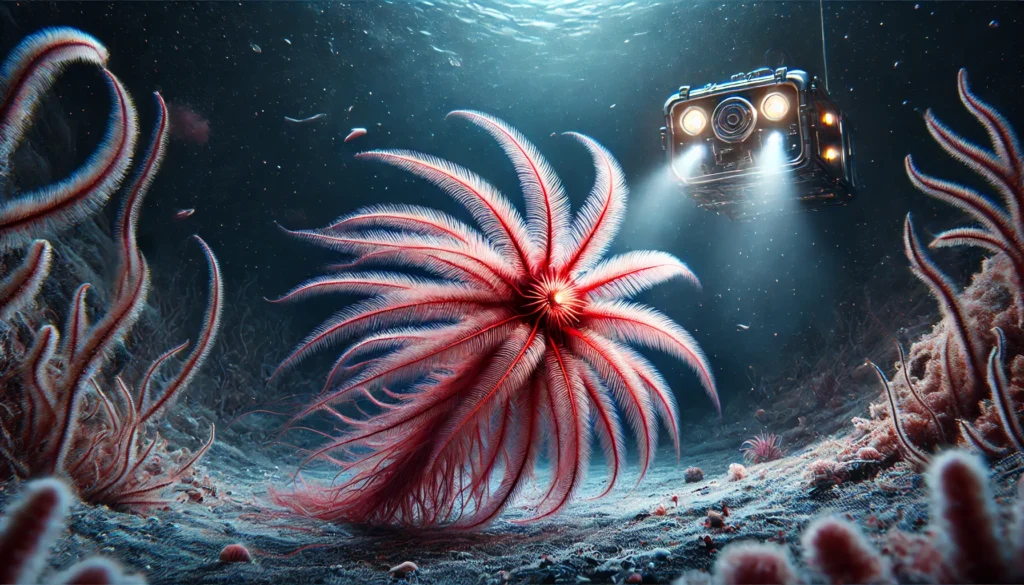The Antarctic Strawberry Feather Star: A Marvel of the Deep

The Antarctic strawberry feather star, scientifically known as Promachocrinus fragarius, is one of the most fascinating marine creatures discovered in recent years. With its unique strawberry-like body and an astonishing 20 arms, this species has captured the attention of scientists and the public alike. Found in the icy waters of Antarctica, this free-swimming crinoid is a testament to the mysteries that lie beneath the ocean’s surface. In this article, we’ll dive deep into the world of the Antarctic strawberry feather star, exploring its description, habitat, discovery, and the scientific significance of this extraordinary creature.
What is the Antarctic Strawberry Feather Star?
The Antarctic strawberry feather star, or Promachocrinus fragarius, is a species of crinoid, a type of marine animal that belongs to the echinoderm family, which also includes starfish and sea urchins. Unlike its relatives, this feather star is stemless and free-swimming, making it a unique member of its group. Its name is derived from its striking resemblance to a strawberry, with a rounded body and a vibrant color range that varies from purplish to dark reddish hues.
Physical Characteristics
The Antarctic strawberry feather star is a large creature, though exact measurements of its size are still being studied. It boasts 20 arms, each adorned with feathery appendages that give it a delicate, almost otherworldly appearance. These arms are not just for show—they play a crucial role in the creature’s survival, helping it navigate the ocean currents and capture food. The body of the feather star is compact and rounded, resembling the shape of a strawberry, which is how it earned its charming nickname.
Unique Adaptations
One of the most intriguing aspects of the Antarctic strawberry feather star is its ability to thrive in the harsh conditions of the Antarctic Ocean. Its feathery arms are highly flexible, allowing it to move gracefully through the water. Additionally, its vibrant coloration may serve as a form of camouflage or a way to attract mates in the deep, dark waters where it resides.
Discovery of the Antarctic Strawberry Feather Star

The Antarctic strawberry feather star was officially described in 2023, marking a significant milestone in marine biology. The discovery was made by a team of researchers from the Scripps Institution of Oceanography and the University of California, San Diego, who conducted multiple expeditions between 2008 and 2017. Their goal was to explore the “cryptic biodiversity” of the Southern Ocean, and their efforts led to the identification of several new species, including the Antarctic strawberry feather star.
The Role of Antarctic Currents
The dispersal of the Antarctic strawberry feather star’s larvae is heavily influenced by the powerful currents of the Southern Ocean. These currents play a crucial role in distributing the species across different regions, ensuring its survival in the vast and often inhospitable Antarctic waters. The discovery of this species highlights the importance of understanding ocean currents and their impact on marine life.
Media Attention
The Antarctic strawberry feather star quickly gained media attention due to its unique appearance and the fascinating story behind its discovery. Articles in Popular Science, Gizmodo, and other outlets brought this mysterious creature into the spotlight, sparking curiosity and wonder among readers worldwide. Its strawberry-like shape and 20 arms even led some to compare it to something out of a science fiction movie, with one netizen describing it as giving off “Aliens movie vibes.”
Habitat and Distribution
The Antarctic strawberry feather star is found in the frigid waters surrounding Antarctica, at depths ranging from 65 meters (213 feet) to 1,170 meters (3,840 feet). Its type locality is the South Sandwich Islands, a remote and largely unexplored region of the Southern Ocean. This species thrives in the unique environmental conditions of the Antarctic, where cold temperatures and strong currents create a challenging yet nutrient-rich habitat.
Adaptations to the Antarctic Environment
Living in such extreme conditions requires specialized adaptations. The Antarctic strawberry feather star has evolved to withstand the cold and pressure of the deep ocean. Its feathery arms are not only used for movement but also for capturing plankton and other small organisms that drift by in the currents. Additionally, its vibrant coloration may help it blend into its surroundings or communicate with other members of its species.
Importance of Antarctic Biodiversity
The discovery of the Antarctic strawberry feather star underscores the incredible biodiversity of the Southern Ocean. Despite its harsh conditions, this region is home to a wide variety of unique and often undiscovered species. Protecting this fragile ecosystem is crucial, as it plays a vital role in the global marine environment.
The Antarctic Strawberry Feather Star in Popular Culture
The Antarctic strawberry feather star has not only captured the attention of scientists but has also made its way into popular culture. Its striking appearance and the story of its discovery have inspired articles, social media posts, and even discussions about its potential as a subject for a TV show or documentary.
A Potential TV Show Star?
Given its unique appearance and fascinating backstory, the Antarctic strawberry feather star could easily become the star of a nature documentary or TV show. Imagine a series that explores the depths of the Antarctic Ocean, showcasing the incredible biodiversity of this region and highlighting the discovery of this remarkable creature. Such a show could educate and inspire viewers, bringing the wonders of the deep sea into living rooms around the world.
Social Media Frenzy
The Antarctic strawberry feather star has already caused a stir on social media, with users marveling at its otherworldly appearance. Comments like “Getting Aliens movie vibes” and “This looks like something from another planet” are common, reflecting the sense of wonder and curiosity that this creature inspires.
Scientific Significance of the Antarctic Strawberry Feather Star

The discovery of the Antarctic strawberry feather star is more than just a fascinating addition to the list of known species—it has significant implications for our understanding of marine biology and the biodiversity of the Southern Ocean.
Resolving Taxonomic Complexities
The identification of the Antarctic strawberry feather star is part of a broader effort to resolve the taxonomy of the Promachocrinus genus. This work helps scientists better understand the relationships between different species and their evolutionary history. By studying the Antarctic strawberry feather star, researchers can gain insights into the adaptations that allow crinoids to thrive in extreme environments.
Conservation Implications
The discovery of new species like the Antarctic strawberry feather star highlights the importance of protecting the Southern Ocean and its unique ecosystems. As climate change and human activities threaten marine environments, understanding and preserving biodiversity becomes increasingly critical.
FAQs About the Antarctic Strawberry Feather Star
1. What is the Antarctic strawberry feather star?
The Antarctic strawberry feather star, or Promachocrinus fragarius, is a species of free-swimming crinoid found in the waters of Antarctica. It is known for its strawberry-like body and 20 feathery arms.
2. How big is the Antarctic strawberry feather star?
While exact measurements are still being studied, the Antarctic strawberry feather star is described as a large creature. Its size is comparable to other crinoids, which can range from a few centimeters to over a meter in length.
3. Where is the Antarctic strawberry feather star found?
This species is found in the Southern Ocean, particularly around Antarctica, at depths ranging from 65 meters to 1,170 meters.
4. Why is it called the Antarctic strawberry feather star?
The name comes from its resemblance to a strawberry, with a rounded body and vibrant coloration. The “feather star” part of its name refers to its feathery arms.
5. What is the significance of its discovery?
The discovery of the Antarctic strawberry feather star highlights the biodiversity of the Southern Ocean and provides valuable insights into the adaptations of marine life in extreme environments.
Conclusion
The Antarctic strawberry feather star is a true marvel of the deep, showcasing the incredible diversity and adaptability of life in the ocean. Its discovery not only adds to our understanding of marine biology but also reminds us of the many mysteries that still lie beneath the waves. As we continue to explore and study the oceans, who knows what other extraordinary creatures we might find?
